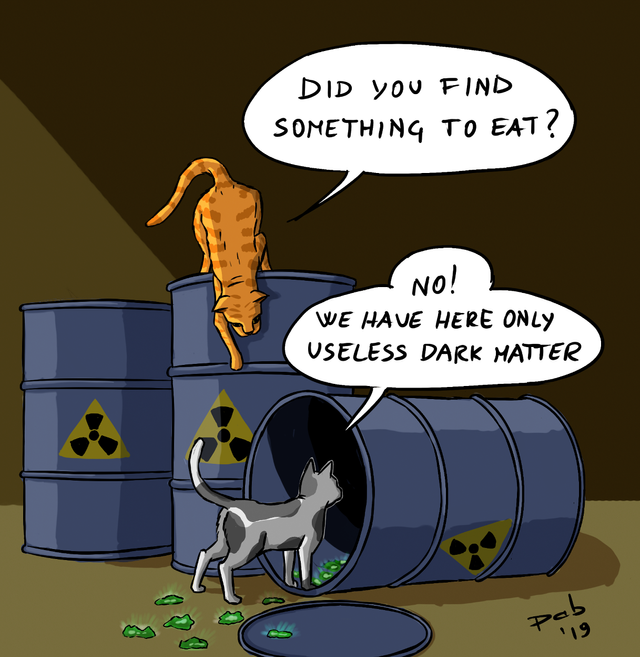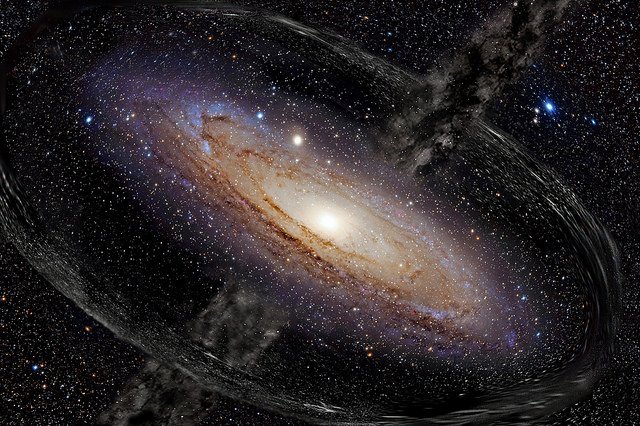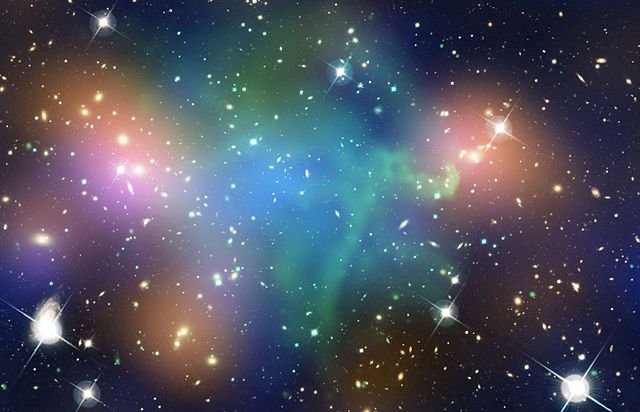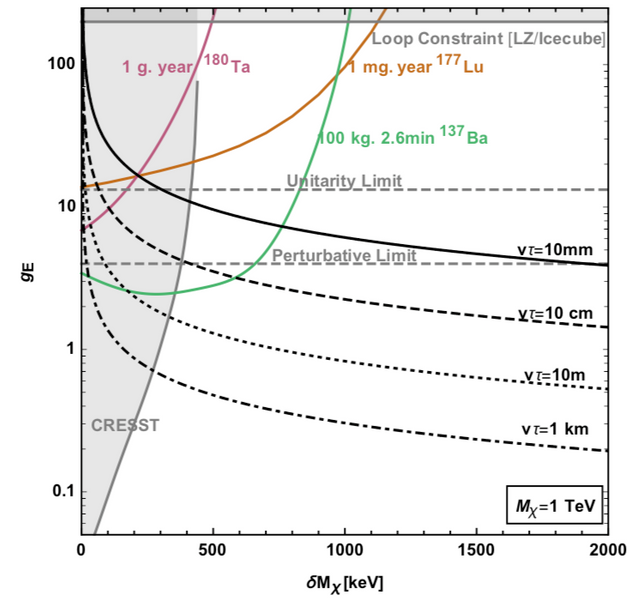Upgrading nuclear and medical waste to dark matter detectors
A novel idea to probe specific classes of potential dark matter particles was recently suggested in this scientific article. It consisted in giving a second life to medical and nuclear waste as dark matter detectors. Before moving on with the details, let us come back a little bit on dark matter.

[image credits: @pab.ink]
Detecting dark matter
Dark matter is probably one of the most searched for beasts in (astro)particle physics today, as it is indirectly evidenced by many cosmological observations. It however still escapes direct detection so that its true nature remains unknown.
This has led to the development of a plethora of theories featuring a particle playing the role of dark matter. In many of these theories, dark matter is expected to be observable on Earth in experiments relying on its very rare interactions with normal matter.

[image credits: Maxwell Hamilton (CC BY 2.0)]
In practice, we wait for dark matter to hit one of the atomic nuclei of the detector material, which is then recorded to derive the properties of dark matter.
Dark matter particles must however be energetic enough to dump energy in the detector.
Dark matter can however be quite different so that these experiments would be significantly less sensitive. For instance, if dark matter is more strongly interacting, it could deposit all its energy in the atmosphere before reaching any ground-based detector (see e.g. here).
The newly introduced idea proposes to rely on an opposite mechanism. Instead of looking for dark matter depositing energy into normal matter, we could consider normal matter supplying energy to dark matter.
Recycling waste!

[image credits: Chandra @ NASA (public domain)]
In order for nuclei to provide energy to dark matter, we need a detector made of atomic nuclei lying in an excited state.
When hit by a dark matter particle, such an excited atomic nucleus is de-excited, and release energy that is transferred to dark matter.
One could then directly observe the nuclear decay, or use standard detectors as dark matter has become more energetic.
However, where to find excited nuclei in large enough quantities to make a dark matter detector? The answer is simple. Nuclear and medical waste contains a large amount of long-lived nuclear isomers that are patiently waiting to be given a second life.
Dark matter is an option for their new life: these isomers could be packed close to an existing dark matter facility and then provide a mean to implement the new detection idea.
Could this work?
To illustrate the expectation of this new dark matter detection method, we can pick up a class of dark matter model and see how it is covered, as shown below.

[image credits: arXiv ]
The two axes of the figure represent the two free parameters of the model. The grey areas are configurations excluded by current experiments. The three coloured curves consist in what the new method could do.
Anything above these curves is expected to be excluded by three isomers, i.e. 180Ta (very abundant in nature), 177Lu (remnant of cancer treatments) and 137Ba (nuclear waste).
As can be seen from the figure, nuclear waste give access to many new configurations not reachable by standard techniques.
Take-home message
I discussed today a novel method for probing dark matter. It relies on the transfer of energy from an excited atomic nucleus (as available by giving a second life to nuclear and medical waste) to dark matter, making it easier to detect with standard techniques in cases where they would otherwise fail.
Whilst all of this lies at the theoretical level at the moment, it would be interesting to put it in place experimentally. But for that, we need to wait… at least a bit!
PS: This article has been formatted for the steemstem.io front-end. Please see here for a better reading.
SteemSTEM
SteemSTEM aims to make Steem a better place for Science, Technology, Engineering and Mathematics (STEM) and to build a science communication platform on Steem.
Make sure to follow SteemSTEM on steemstem.io, Steemit, Facebook, Twitter and Instagram. Please also consider to support our witness (@stem.witness) or to delegate to @steemstem for a ROI of 65% of our curation rewards.
I wrote a comment and lost it before I hit 'submit', so here I go again.
I'm not a fan of nuclear energy for at least 3 reasons:
Feeding nuclear waste to dark matter takes care of objection #3. However, a nagging thought, which probably reflects my profound ignorance:
Do we want energized dark matter? Doesn't dark matter gobble up everything in its path. Do we want to supercharge this entity?
Thank you for making theoretical physics accessible. There was a time when I would see the words 'dark matter' and hurry off because it had nothing to do with me. Now I feel much more comfortable with the 'matter' :)
I do not think nuclear energy is the future as well. However, with climate changes and our way of living (as humans on the planet), this is currently the only way. What is missing is definitely a lot of funding to develop more efficient and clean alternative source of energies, and get ideas on what to do with nuclear waste.
In my post, I depict an idea to give waste a second life. However, only a tiny fraction of the isomers will de-excite through this 'dark matter portal' as this consists in super rare events (a few per year at most).
Therefore, this does not really solve the problem. This is anyways another debate (tagging @apsu just in case he wants to take part to this discussion).
Finally, note that concerning the pollution of the areas surrounding the nuclear plats, I am not sure this is really worse than what happens close to coal plants. In any case, we end up with the same conclusions of what I quoted above: we need more funding for the appropriate research to be able to find the good solutions.
The potential dark matter particles that can interact with the excited isomers are those that are not energetic enough to leave tracks in current dark matter direct detection experiments.
Giving dark matter a little boost (we do not talk about large amounts of energy) would then make it visible in those experiments. One needs however to keep it mind that dark matter very rarely interacts with anything (regardless its energy). Therefore, this will solely increase by a little (as visible in the last image of the post) the chances to observe it.
Feel free to ask any further clarifications!
PS: in my next post (end of next week probably), I will discuss both dark matter and black holes; I could however go back to colliders later on (I will probably skip any writing in French at the moment, due to the impressive amount of comments I got in my last French post ;) ).
Thank you for entertaining my freestyle commentary. It's your fault...you make us comfortable with physics. It's a wonderful thing. I almost regret skipping the subject in high school. But then, there was entirely too much homework overall and I did (still do) enjoy my quiet time.
So you see, I learn from you now. I did not need to use up my peaceful evenings all those years back with onerous assignments :))
Looking forward to the next gentle foray into the arcane mysteries of theoretical physics.
I am happy to do this. I feel like physics being a little bit under-represented in SteemSTEM and I am trying to compensate ;)
Note that discussing about what has been done and doing the actual calculations is a different story. However, there is always a way to discuss things nicely enough to motivate students to start with the computations. Even at high school or below (my son, who is now 8, was explaining quantum mechanics to his friends when he was 6 :D ).
In any case, thanks for your very nice words. They are very appreciated!
🙂
Hi @lemouth,
Here I'm again reading about dark matter. Its elusive nature is what fascinates me most of all. So, learning about the steps that are being made towards its detection is rather intriguing for me now :)
I like how you presented this new method of "resurrecting" nuclear compounds through dark matter, as a means to detect it (?). It was straight-forward and straight to the point. It makes the read for someone like me quite exciting actually.
I also went through your comment section, which led me to another post of yours that, in fact, gave me an idea of the whole motivation behind the search for dark matter. This has made/will make my readings of materials about this topic much more meaningful :)
Thank you.
Have a nice afternoon!
As we discussed earlier (in one of your posts or mine, I don't remember), I am now trying to make shorter posts, easier to read with much less details (questions on the details can always come in the comments, where I am glad to give more information). I am happy if you liked this post and if it was clear (enough). :)
You can remove the question mark from your sentence. This is the exact idea.
To rephrase and summarise the post a little: One should take all these pieces of nuclear waste, put them together so that we will have a large amount of matter living in an excited state and staying excited (because those pieces of waste have a very long lifetime). If a stealthy dark matter particle comes around, the excited waste gets a mean to de-excite (thank you dark matter!) by transferring its energy to dark matter. As a result, dark matter is now more energetic and the experiments targeting it have can detect it more easily.
Enjoy your day as well!
This would be interesting of it would work. Even though I did not grasp the plot properly, I assume it takes care of interaction of nucleus that might happen with other stuff, say neutrinos and dark matter would have it's own characteristic signature. I guess that's what you meant?
On a slightly unrelated note this question came to my mind. Do we even know that dark matter flows through earth or earth passes through some region full of dark matter? How would we ensure that dark matter interaction would occur here on earth?
Thanks for the questions! I am pleased to provide answers!
I did not want to add too many details on the plot in order to only stress the essence of it. In fact, it represents the parameter space of a given model for a fixed dark matter mass. The y-axis corresponds to the dark matter electric dipole (that can be tuned to any value) and the x-axis to the mass difference between dark matter and a second, instable, dark state (that decays into dark matter).
To make a long story short, those are the two parameters that are left in this model, as soon as the dark matter mass has been fixed.
From there, we can calculate predictions for what should be visible in current experiments and verify that we do not violate any experimental bounds. This excludes the grey area of the parameter space.
In the next step, we can evaluate how waste would yield potentially observable signals. After assuming that the idea has been concretised experimentally and some capabilities for the corresponding experiments, we get the three coloured lines.
If nature is realised according to the model under consideration and if the parameter setup lies above the coloured lines, then dark matter will be found.
Does it clarify?
We know the distribution of dark matter in the galaxy. If you assume dark matter exists in the first place, then there is a density of dark matter around us of 0.02 solar mass per cubic parsec. See for instance here for some recent results.
To put some funny numbers in perspective, this means that there are about 1000 tons of dark matter in the Sun.
I hope this helps! Feel free to come back to me if needed!
This article particularly piqued my interest because of the likely application of nuclear waste as a detector. Have always being fascinated by the use of nuclear for energy production but somehow not too eager with how to manage the waste that will surely follow with running such an operation
Let's see how this theories work out in practice. I'm keeping my fingers crossed while we wait
One must be careful here. it is true that this gives us something to do with the waste during some time. However, most of the waste will still be waste after the experiments. The reason is that dark matter interacts very weekly, so that it will interact only very little with the excited isomers. But at least, this may buy some time to further think about what to do with those pieces of waste...
It was nice to read from you! It was a long time ^^
And that just flies around at earth? I suppose it interacts with gravity, so it might get stuck here.
Around Earth and all over the galaxy. It is necessary to have a local density of dark matter to explain the cosmological observations. It can be accreted in massive objects (through gravitational forces), but the Earth is probably too light to yield any observable effect. However, the story is different with the Sun. See for instance here for more information on how physicists could use that to probe dark matter.
This post has been further promoted on Facebook, Instagram, Reddit and Twitter by the SteemSTEM team!
dark matter detectors for what? mmmm well, it's a more efficient type of energy for use... much safer .. i mean, dark matter
I am not sure to have understood the question. We are discussing detectors to detect dark matter particles, which has nothing to do with producing energy.
Maybe if you could clarify a little bit, I could answer better? Thanks in advance!
Nice one bro.
Like your all blog bro.